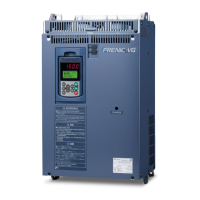6.13 AIO Expansion Card
6-237
Chap. 6
CONTROL OPTIONS
6.13 AIO Expansion Card OPC-VG1-AIO
6.13.1 Product overview
The FRENIC-VG incorporates six built-in analog I/O points, i.e., one I/O point
each allocated to pin numbers [Ai1], [Ai2], [AO1], [AO2], and [AO3] besides an
input point (speed command input dedicated) dedicated to number 12.
The use of an optional OPC-VG1-AIO expansion card makes it possible to add 2
[Ai] and 2 [AO] points.
(1) Main applications
The OPC-VG1-AIO enables control functions that are the same as those of the
built-in analog I/O of the FRENIC-VG. For example, the available analog input
functions include auxiliary speed setting 1, torque bias, torque command, and
magnetic flux reference functions and analog output functions include
speedometer, torque meter, torque current meter, and line speed detection
functions.
(2) Covering a shortage of analog I/O points
Apply the OPC-VG1-AIO to a system employing the UPAC (available soon) or control system that uses
the built-in PID control of the inverter if the number of built-in analog I/O points is insufficient.
In the case of using the WPS-VG1-TEN in tension control, for example, the three built-in points of the
FRENIC-VG will be all occupied for line speed, tension setting, and tension detection purposes. This
expansion card will be required if the user wants to add one more point to such a system.
If the system, however, uses the OPC-VG1-SN as an optional synchronous interface for dancer control,
this expansion card cannot be used due to the mounting limits on the analog option. Furthermore, if the
built-in PID control of the inverter is used, the PID command (for process settings) and PID feedback
amount (process amount) will occupy Ai1 and Ai2. This expansion card will be required if the user wants
to add a point, e.g., a PID correction gain, to the system.

